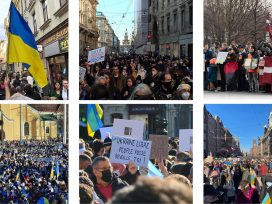The importance and danger of numbers
Inaugural address at the 26th European Meeting of Cultural Journals, Conversano, 3 October 2014
Your Excellencies,
Dear Mr President,
Mr Galli,
Dear friends and colleagues from Conversano and beyond,
We have asked Carlo Galli to deliver the opening speech of this the 26th European Meeting of Cultural Journals under the heading “1814–1914–2014”. Not very original, some of you might say. Well, perhaps not. But then again, I would urge you to have a closer look at the title. Small differences are sometimes important.
I have already lost count of the conferences, panel discussions and articles I have attended and read (not written) which all draw an arch, connecting the start of the First World War in 1914 with contemporary developments in Europe in 2014: the return of nationalism; the crisis of the European project and much more of the same…
Politicians read a lot – policy papers, statistics, public enquiries – but they rarely read books. This year, however, in the anniversary year 2014, many of them have read books. My bet is that is was Christopher Clark’s Sleepwalkers that was on the nightstands of those European politicians, who during long days have been occupied finding adequate responses to the crisis in Ukraine and the new, aggressive Russian foreign policy. And if it wasn’t Christopher Clark’s Sleepwalkers – as in the case of Angela Merkel – then it was one of the many other historical accounts of those decisive days in August 1914 when well-meaning European leaders were led into brutal conflict.
You are what you eat and you become what you read: in recent months there has been nothing that these politicians have feared more than overreacting – this is the lesson of 1914, which has determined much of the European response to the events in Ukraine 2014.
But what if the reference would instead have been 1814? The year when the Congress of Vienna opened?
What was the Congress of Vienna? Well, in short there were two objectives dominating the negotiations: first, the preservation of political equilibrium of the main European powers; and secondly, the restoration of old dynasties that had been ousted by the preceding revolutionary wave.
The result was a new European security doctrine: the establishment and confirmation of so-called legitimate spheres of influence; geographical areas regarded as “belonging” to one of the great powers, independent of the “real” – at the time often defined as national – interests of these regions.
And if we look closely: is this not what we see happening today? In the anniversary year 2014 we can observe the reestablishment of a security doctrine that makes it possible to define some geographical areas, some European states, as nothing but buffer zones, belonging to a “sphere of interest” that disregards the right to “self determination”.
We might think that this is a good new world order. Many of us will think that it’s a very dangerous development. But at least we need to see what is happening. And here historical perspectives might be helpful; not only 100 years back, but 200 years. Therefore 1814–1914-2014.
As many of you will recall, it was on 30 November last year – when we convened in Oslo – that the brutal violence of Viktor Yanukovych’s Berkut police turned the protest on the Kyiv Maidan into a people’s movement. Some would say, turned this protest into a revolution. Fifty thousand protesters over night became half a million.
There has hardly been one single day since then that the events in Ukraine have not hit the headlines of the world’s newspapers and news casts.
Just a few days ago, when we all were occupied preparing our trip to Conversano, it was reported that the number of people confirmed killed in the conflict in eastern Ukraine has risen above 3000 – including the victims of the Malaysian Airlines plane crash.
Numbers and figures are dangerous things. By putting one figure next to another you suggest that the reality behind these numbers are comparable – and that these numbers at all say anything relevant about reality. These are dangerous assumptions.
However, at the beginning of this meeting; I would like to give you one more figure.
Just a couple of days ago, when we all were packing our bags to go to Conversano, it was reported that the death toll of migration in the Mediterranean just passed 3000. So far this year, at least 3,072 people have died in these waters, while trying to reach the shores of Europe. That is roughly 75 per cent of all migrant deaths in the whole world this year (4,077).
There is no way around such figures but I hope that the next few days here in Conversano will provide an opportunity to go behind and beyond pure numbers. In any case, I can’t think of any better place to discuss these matters.
Published 3 October 2014
Original in English
Translated by
Carl Henrik Fredriksson
First published by Eurozine
© Carl Henrik Fredriksson / Eurozine
PDF/PRINTNewsletter
Subscribe to know what’s worth thinking about.


